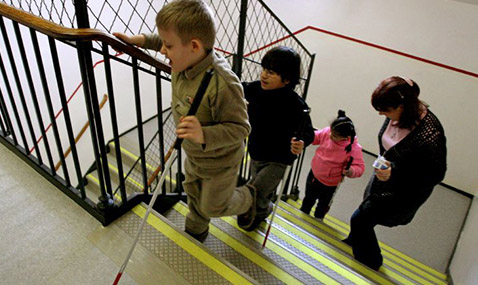<< Learning Center
Media Accessibility Information, Guidelines and Research
Perspective: Examining the Process of Audio Description
By Alice Austin
Imagine that you are a blind, fourth-grade girl and that your class is watching a film that examines prejudice and bullying in our culture. The film is a drama, where young girls shoot scornful glares, roll their eyes, and whisper about a new student. Instead of aggressive bullying, they get up and leave when the new girl approaches. Now imagine that you're studying human anatomy in high school. The brilliantly colored graphics of today's film show how blood flows through the heart's ventricles and oxygen inflates the bronchioles in the lungs.

These are just two examples of videos I have described for The Described and Captioned Media Program, a leading resource for accessible educational materials and promoter of accessibility in education. In working with DCMP, I am able to participate in not only the formal, but cultural, education of students who are constantly faced with visual cues to which they often have no access.
As an audio describer for the past several years, I have described countless films, television programs, and live events. As an independent contractor, I find that the process can vary widely depending on the vendor, but DCMP has a system in place that is simple and results in an accurate, high-quality product. Not only do they provide extensive resources to educators, clients, and the blind and visually impaired community, their Description Key is a valuable tool for describers. It presents guidelines for the description process as well as concise lists of resources for consumers and clients.
Although the description process can vary depending on the media being described, I find that my general approach is the same. I start by surveying the big picture. What is the media? What is the most important information that needs to be conveyed? Who is my audience? Is there a target age group or any assumed knowledge of the material? How much time do I have to get my description across? The questions go on and become more specific, and once I have answers regarding my project as a whole, I continue this line of questioning for each pause that I describe. It can be a challenge to funnel all of this information into a three second pause and a different kind of challenge to fill a ten minute pause. Of course, with ten minutes it sometimes feels like I have all the time in the world to paint an accurate, compelling picture with words. However, I then have to match the pace and timing of the description to the action of the scene.
In general, describers want to maintain the integrity of the original program by not talking over the existing dialogue. This can be difficult, especially when a program has its own narration, such as in a documentary, or has very short pauses throughout. At these times, the audio description may be fairly minimal, with perhaps some license taken to describe what is vital to the understanding of the program. Within a long pause, background sound effects can be lowered or allowed to come through as audible cues. All this is to be done as unobtrusively as possible. Audio description should feel like a natural addition to the media at hand, and I allow the production to guide me in pace and tone.
What I love most about describing is the investigation, the analysis of the media, the weeding out of less vital information and the building up a structure of details that lead the viewer's imagination to the same place, at the same moment, as that of a sighted observer. While I enjoy the challenges of the writing and narration, I am most rewarded when these things become nearly invisible to the listener. Whether I am describing a Degas sculpture, a historic film, a scientific presentation or an action-packed movie, I believe that description for each is equally important to the viewers in sharing the experience with sighted audiences. Hopefully, the momentum that audio description has gained will build until it is an accepted part of accessibility programs throughout the world.
Alice Austin — 1971-2017
Tags:
Please take a moment to rate this Learning Center resource by answering three short questions.
